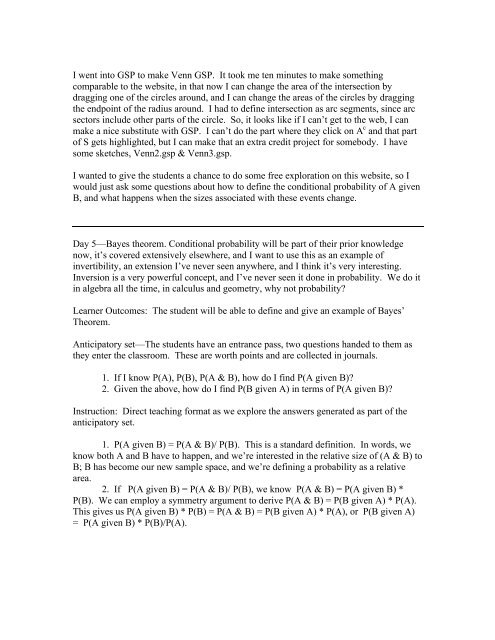MED 607/I2T2 Projectâ5 day lesson plan on geometric probability ...
MED 607/I2T2 Projectâ5 day lesson plan on geometric probability ...
MED 607/I2T2 Projectâ5 day lesson plan on geometric probability ...
- No tags were found...
You also want an ePaper? Increase the reach of your titles
YUMPU automatically turns print PDFs into web optimized ePapers that Google loves.
I went into GSP to make Venn GSP. It took me ten minutes to make somethingcomparable to the website, in that now I can change the area of the intersecti<strong>on</strong> bydragging <strong>on</strong>e of the circles around, and I can change the areas of the circles by draggingthe endpoint of the radius around. I had to define intersecti<strong>on</strong> as arc segments, since arcsectors include other parts of the circle. So, it looks like if I can’t get to the web, I canmake a nice substitute with GSP. I can’t do the part where they click <strong>on</strong> A c and that partof S gets highlighted, but I can make that an extra credit project for somebody. I havesome sketches, Venn2.gsp & Venn3.gsp.I wanted to give the students a chance to do some free explorati<strong>on</strong> <strong>on</strong> this website, so Iwould just ask some questi<strong>on</strong>s about how to define the c<strong>on</strong>diti<strong>on</strong>al <strong>probability</strong> of A givenB, and what happens when the sizes associated with these events change.Day 5—Bayes theorem. C<strong>on</strong>diti<strong>on</strong>al <strong>probability</strong> will be part of their prior knowledgenow, it’s covered extensively elsewhere, and I want to use this as an example ofinvertibility, an extensi<strong>on</strong> I’ve never seen anywhere, and I think it’s very interesting.Inversi<strong>on</strong> is a very powerful c<strong>on</strong>cept, and I’ve never seen it d<strong>on</strong>e in <strong>probability</strong>. We do itin algebra all the time, in calculus and geometry, why not <strong>probability</strong>?Learner Outcomes: The student will be able to define and give an example of Bayes’Theorem.Anticipatory set—The students have an entrance pass, two questi<strong>on</strong>s handed to them asthey enter the classroom. These are worth points and are collected in journals.1. If I know P(A), P(B), P(A & B), how do I find P(A given B)?2. Given the above, how do I find P(B given A) in terms of P(A given B)?Instructi<strong>on</strong>: Direct teaching format as we explore the answers generated as part of theanticipatory set.1. P(A given B) = P(A & B)/ P(B). This is a standard definiti<strong>on</strong>. In words, weknow both A and B have to happen, and we’re interested in the relative size of (A & B) toB; B has become our new sample space, and we’re defining a <strong>probability</strong> as a relativearea.2. If P(A given B) = P(A & B)/ P(B), we know P(A & B) = P(A given B) *P(B). We can employ a symmetry argument to derive P(A & B) = P(B given A) * P(A).This gives us P(A given B) * P(B) = P(A & B) = P(B given A) * P(A), or P(B given A)= P(A given B) * P(B)/P(A).
















